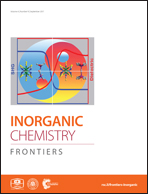Dielectric and nonlinear optical dual switching in an organic–inorganic hybrid relaxor [(CH3)3PCH2OH][Cd(SCN)3]†
Abstract
A new organic–inorganic hybrid compound [(CH3)3PCH2OH][Cd(SCN)3] (1) has been synthesized, which exhibits a reversible phase transition at 248.5 K confirmed by differential scanning calorimetry. The phase transition in 1 is from a centrosymmetric space group Pmcn to a non-centrosymmetric space group P21, so that 1 exhibits a switchable second harmonic generation (SHG) effect between SHG-on and SHG-off states. This phase transition also displays switchable dielectric behaviors between high and low dielectric states accompanied by the remarkable dielectric relaxation described by the Cole–Cole equation. Variable-temperature single-crystal X-ray diffraction analyses reveal that the origin of the phase transition can be attributed to the motion or reorientation of the [(CH3)3PCH2OH]+ cations and the movement of (SCN)− ions in solid-state crystals. These superior physical properties suggest that 1 could be a potential switchable dielectric and NLO relaxor-type material, which provides a new approach to design novel multiple switch materials.
![Graphical abstract: Dielectric and nonlinear optical dual switching in an organic–inorganic hybrid relaxor [(CH3)3PCH2OH][Cd(SCN)3]](/en/Image/Get?imageInfo.ImageType=GA&imageInfo.ImageIdentifier.ManuscriptID=C7QI00300E&imageInfo.ImageIdentifier.Year=2017)
- This article is part of the themed collection: Inorganic Chemistry Frontiers HOT articles for 2017


 Please wait while we load your content...
Please wait while we load your content...